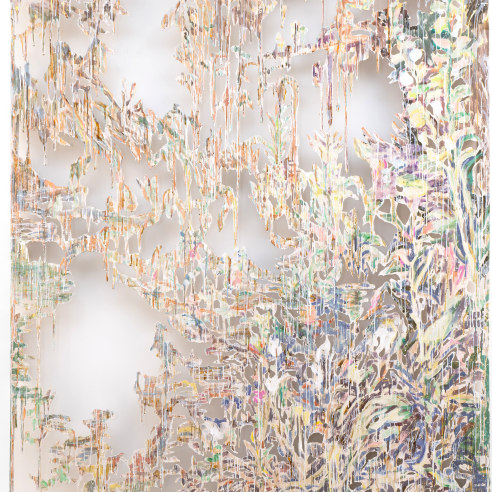
Linda Vaughn (left), Jane Jackson and Freda Scott look at “Storms of Gold,” by Diana Al-Hadid, which is one of the art pieces featured at the Fog Design + Art fair in the Fort Mason Festival Pavilion in San Francisco.Photo: Carlos Avila Gonzalez / The Chronicle
There’s a game I play at art fairs: Predict what the social media standout will be, then check Instagram to see what art was posted the most.
With two art fairs — Fog Design + Art and Untitled, Art — taking place in San Francisco last week, it gave me another opportunity to play my game and to explore how social media is affecting the art-going experience.
In recent years, Kohei Nawa’s “PixCell-Maral Deer” presented by Pace Gallery, and Ai Weiwei’s gilt-covered stainless steel bicycle sculpture “Forever” presented by the Haines Gallery were Instagram favorites at Fog, while Michele Pred’s “Power of the Purse” installation presented by the Nancy Hoffman Gallery stood out at Untitled, Art. On the surface, the pieces have little in common, but all had the ability to attract people to them and spark a desire to share the work on Instagram.
Almost immediately upon arriving at the Fog opening on Wednesday, Jan. 15, I was asked: “Have you seen the breast?” These fairgoers were referring to “Le Sein,” a 1966 bronze sculpture by artist César Baldaccini presented by New York gallery Luxembourg & Dayan.
Taking up roughly 7 feet of space at the front of the booth, people would walk by the sculpture, stop, widen their eyes in recognition, then snap a picture. The gallery’s registrar, Alyssa Matthews, said that the placement of the piece was important because “seeing this work out in the open will also translate really well in social media photography.” Will it ’gram? Strong contender for “breast in show.”
At the Nicholas Kilner Gallery’s space, Superstudio’s 1968 “Bazaar Sofa” was a standout. The white, fiberglass half-shell design had many people asking to be photographed sitting inside the faux-fur-lined canopy. Kilner had no objection: In the three years he’s exhibited at Fog, he said Instagram had become an unavoidable part of the experience. Will it ’gram? Anytime you can directly interact with a piece, its social media success rate goes up.
Behind the David Zwirner space, the New York gallery hung two lighting tube sculptures, “Untitled (in memory of Josef Albers) 1 and 2,” by Dan Flavin, an artist with a number of pieces in the San Francisco Museum of Modern Art’s permanent collection. Kristine Bell, senior partner at Zwirner, said that she heard from SFMOMA that the museum’s Flavin installations are among the most Instagrammed in the collection. “Maybe this will be an Instagram hit,” said Bell, “but we don’t go into the fairs thinking about that.”
Will it ’gram? 50/50. Flavin’s name recognition in San Francisco is a plus, but the difficulty of photographing light sculpture may be a negative.
At Gagosian, Northern California artist Michael Heizer’s “Negative Wall Sculptures” had a line of people waiting to have themselves photographed in front of the giant rock formations that were embedded into the wall. “Anything that gets people looking at and talking about art is ultimately beneficial to us,” said senior Gagosian Director Kara Vander Weg, adding that she hoped “people will talk to us about it or pick up a book or look it up on the Internet.”
Will it ’gram? The scale and dimensionality may help the pieces rock on to fair favorite.
At Stanlee Gatti’s 21 Pop installation, Jack Morningstar’s “The Smoke and L’s Chair” had a lot of social media potential. Not only did the chair light up, but also at the press of a button the base of the piece filled with fog, making the laser lights inside even more visible. Morningstar, a recent graduate of California College of the Arts’ furniture making program, calls himself “a pro Instagrammer” who uses it as much for education about other artists’ work as he does to promote his own. Will it ’gram? Given both the popularity of light shows and 21 Pop’s prominent placement at the front of the fair, Morningstar’s chair could knock some of the more established artists’ works out of the top spot.
But many gallerists warned we should not reduce the art fair experience to what we see on social media. Bellatrix Hubert, a senior partner at David Zwirner Gallery, said that artists generally want people to engage with their work “with all their senses” and that the snap-and-go mentality of some Instagrammers can be counter to that.
“There’s a very strong intellectual and emotional component that can be lost,” said Hubert.
Becky Heldfond, the director of San Francisco’s Berggruen Gallery, said that while Instagram has helped broaden the gallery’s audience in recent years, it’s important to remember that “what you see on social media presents only a very specific viewpoint,” and that visiting fairs and dealers in person is essential to having an experience more truly reflective of the art world.
Ultimately, I see both the pluses and minuses of how Instagram is changing art experiences. The “snap-and-go” approach to the art is superficial at best, but dismissing the impact seeing a work on Instagram can have on someone who is unable to physically attend the fairs is a form of elitism. If Instagram allows you to more deeply engage with art, it more than makes up for fairgoers only there for selfies.
Projected Instagram Favorite: “The Smoke and L’s Chair” for freshness, interactivity and fair placement.
